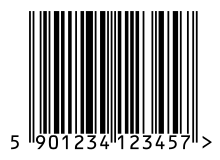European Article Number
The European Article Number (often shortened to EAN) is a standard to encode product numbers. The EAN is a special case of a Global Trade Item Number. The EAN is made of either 8 or 13 digits (EAN-8, and EAN-13). In many cases, the EAN allows to uniquely identify the item. Most of the time, the EAN is printed on the packaging of a product. Special scanners are able to decode these numbers. They then look up the product-specific data (such as the price) and print it on the bill, for exampe.


Note that the EAN is often encoded using a barcode (such as the ones in the example), but this does not have to be thecase. There are other machine-readable codes which can also be used.
EAN-13/GTIN-13
changeThe standard EAN has 13 digits. The EAN is composed of different sections:
- Country-specific part: 3 digits
- Company part
- Article number: 3-5 digits
- Checksum digit
EAN-8/GTIN-8
changeThe normal length of an EAN is 13 digits. There is also a shorter version called EAN-8, for small packages, where the full 13-digit number would take too much space on the package. The EAN-8 consists of:
- Country-specific part: 2-3 digits
- Article number: 4-5 digits
- Checksum digit
There are special organisations which give out both EAN-8 and EAN-13 numbers. Since EAN-8 numbers with a starting digit 2 are free use, many retailers (such as Aldi) use them for their own products. As an example, Aldi uses EAN-8 codes starting with 290 or 221; 290 and 221 are the country-specific parts "for internal use".